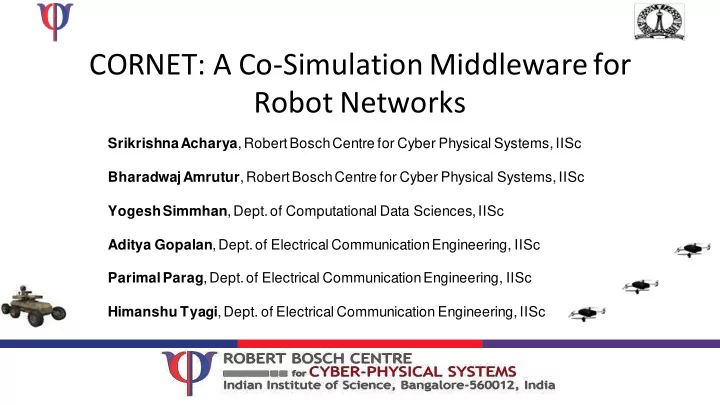

CORNET: A Co-Simulation Middleware for Robot Networks Srikrishna Acharya , Robert Bosch Centre for Cyber Physical Systems, IISc Bharadwaj Amrutur , Robert Bosch Centre for Cyber Physical Systems, IISc Yogesh Simmhan , Dept. of Computational Data Sciences, IISc Aditya Gopalan , Dept. of Electrical Communication Engineering, IISc Parimal Parag , Dept. of Electrical Communication Engineering, IISc Himanshu Tyagi , Dept. of Electrical Communication Engineering, IISc
Introduction Autonomous robots has enormous potential in several domains like search & rescue, surveillance, transport and infrastructure etc. V2X use-cases: remote-controlled autopilot systems, situation aware driver assistance systems. Performance evaluation of such networked systems requires appropriate tools For example: impact of communication artifacts like packet losses, congestion and routing overheads on the control system of the robots.
Problem Statement Develop a co-simulation framework that integrates simulation of flight dynamics and network related aspects. The solution should satisfy the following criteria • Lightweight and scalable to handle complex real-world scenarios • There should be a common notion of time and position across the two simulation environments and • Provides APIs to port control algorithms to a real platforms. Network
Related work UAV Simulators : • human operating flight simulators - Microsoft flight simulator FlightGear • autopilot frameworks - PX4 and ArdupilotSoftware in the loop(SITL) • Robotic Simulators (3D) - AirSimand Gazebo Network Simulators: • commercial network simulators - QualNet and OPNET • open-source simulators - NS-3 and OMNET++ • network emulator - Mininet
Related work Joint UAV-Network Simulators : AVENS : Developed based on X-Plane and OMNET++. HICSS, 2017 - CUSCUS - Developed based on FL-AIR and NS-3. Ad Hoc Networks Volume 68, January 2018, Pages 33-47 - FlyNetSim- Developed based on DronekitSITL and NS-3. - MSWIM, 2018
Related work Application Specific Drone Simulators: Recent Advances and Challenges Open Source Network simulation HEXAGON No No LabVIEW based GUI, Mathematical Models Simbeeotic Yes Limited Java and uses Maven build system MS Flight Simulator X No No proprietary software by microsoft AirSim Yes No useful tool for AI research AVENS Yes Yes Doesn't provide data path for control, telemetry to and from UAVs UAVSim Yes Yes Focus on UAVNet Attacks and security aspects D-MUNS No Yes NS3 based network simulator ROTORS Yes No AseTec, Gazebo project for multi UAV systems.
Our Approach Our choice of Gazebo with ROS and NS-3 in the Linux environment is primarily driven by 1. Better community support, 2. Gazebo has modular software architecture and extended using plug-ins, 3. NS-3 allows interfaces for external systems, applications and libraries.
Co-Simulation Architecture
CORNET Middleware Middleware interconnect Gazebo and NS-3: 1. ZMQ - end to end data path 1. CORNET ROS plugin - mobility and time sync
Why is time synchronization critical Gazebo simulates physical systems – uses period sampling NS-3 simulates network systems – deploys event based sampling Combination of periodic and event based sampling is not a trivial problem.
Time Synchronization The method we have adopted is referred to as the variable- stepped method: • Gazebo sim time is reference clock for which NS-3 simulation is tied. • NS-3 checks for network events and reference clock for execution. • The middleware checks for the packet leaving NS-3 and releases to Gazebo. • If the Packet delayed by NS-3 results in delivery after the time lasped in gazebo sim time, we discard these packets.
Criteria for proper functioning Packet discarding is result of case where NS-3 runs slower than Gazebo simulation. Ideal scenario is to update the clock of Gazebo to match with NS-3. NS-3 event processing should be faster than Gazebo , which is the case in normal execution scenarios.
Evaluation Offboard control of Single UAV: We measure end-to-end network latency for both the real world and the simulation
Evaluation Fixed Trajectory Control: GCS sends commands to the UAV to follow a pre-determined trajectory. This is a way-point based navigation with the controller present in the GCS Simple evaluation of the framework’s ability to develop and test new network functions for UAVNETs.
Comparison Table FlyNetSim CUSCUS AVENS CORNET Network simulator NS-3 NS-3 OMNET++ NS-3 Physics simulator Dronekit SITL FL-AIR X-Plane Gazebo Mobility Deep packet Shared memory XML based ROS topic inspection Data-path ZMQ Ns-3 bridge - ZMQ Time Sync Yes No No Yes
Future Work Modeling latency requirements for Droneport to control drone to enable precise landing, Extend the framework to support LTE and 5G to enable multi-technology networking, Evaluate routing algorithms for UAVNETs specifically position-based routing protocols.
Acknowledgment We would like to thank, IISc’s 5G-V2X group, Department of Telecom, Govt of India Indian National Academy of Engineers for their constant support. We are grateful to our project staff, especially Varun, who provided expertise in Gazebo simulation that greatly assisted the research. Questions
Time Synchronization Time-stepped method Global-event driven method
Recommend
More recommend